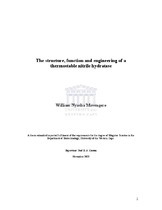| dc.description.abstract | Nitrile hydratases (NHases) are enzymes that catalyse the conversion of organocyanides to amides via a non-hydrolytic hydration reaction. They are industrially relevant enzymes, currently used in the manufacture of nicotinamide and acrylamide. The target of this study belongs to the thermophilic bacteria Geobacillus pallidus. The G. pallidus RAPc8 NHase is a heterotetramer that has a 28 kDa α subunit and a 29 kDa β subunit,
with a α2β2 configured functional unit. The G. pallidus RAPc8 NHase operon has been cloned, sequenced and expressed at high levels in E. coli, with subsequent crystallisation for X-ray diffraction analysis. Current work is based on the study of the reaction mechanism of NHase as proposed by Mitra and Holz (2006). This mechanism implicated βY72 and βW76 in the hydration of nitriles. The study involved the site directed mutation of the β subunit of G. pallidus RAPc8 NHase, resulting in the generation of a βY72FβW76V mutant. This was followed by sequencing, expression and purification of the recombinant protein. The pH-activity and temperature- activity profiles of the mutant showed the enzyme to be optimally active at pH 6.4 and 55oC, respectively. Further kinetic analysis of the mutant found optimal kcat/KM values of 94.7 + 7.5 at 50oC and pH 5.8. The determination of the kinetic parameters under differing environmental conditions such as changes in temperature and pH revealed the ionisation constants of the enzymesubstrate
complex (pKES1 and pKES2) to be 5.9 and 7.7, respectively. These results suggest that the active site sulphinic acid as opposed to the active site tyrosine may be responsible for catalysis. The active site tyrosine probably plays a substrate-stabilising role. The fluctuation of the kcat, KM and kcat/KM values demonstrated the need to use an alternative measure of enzyme efficiency. A more appropriate term could be the enzyme efficiency function, Ef, which considers the dependence of the enzyme efficiency on substrate
concentration. | en_US |

